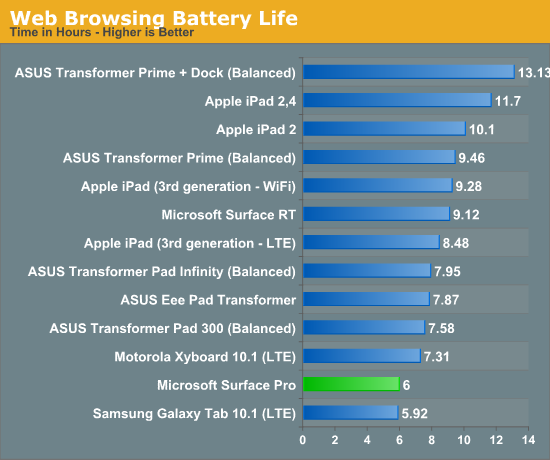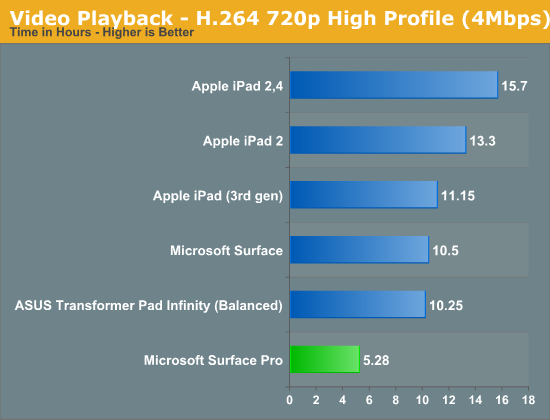Microsoft Surface Pro Review
by Anand Lal Shimpi on February 5, 2013 9:00 PM ESTBattery Life: The Downside
Despite having an integrated 42 Wh battery (similar in size to the 3rd and 4th gen iPads with Retina Display), battery life is a real sore spot for Surface Pro. Haswell is really designed to drive platform power down to very low levels, which should help close the gap between ARM/Atom based tablets and Core based tablets. Unfortunately, Haswell for tablets won’t hit until the third quarter of this year, which forced Microsoft to use Ivy Bridge.
In our tablet benchmarks, I never saw Surface Pro break the 6 hour mark on a single charge. In most cases I’d expect to see 5 - 6 hours out of Surface Pro in light, tablet usage. Video playback was especially disappointing as Surface Pro managed to use more power here than during our web browsing battery life test. I suspect this might have to do with the relative power efficiency of Ivy Bridge's video decoder. It'll be interesting to see how Haswell does in this department.


I also put Surface Pro through some of our new notebook battery life tests for 2013, and here it didn’t fare too bad. I only have Acer’s 13-inch S7 to compare to but Microsoft managed 3.85 hours in our medium workload compared to sub-3 hours for the larger Ultrabook:
| Windows 8 Notebook Battery Tests | ||
| Battery Test | Acer Aspire S7 (13-inch) | Microsoft Surface Pro |
| AnandTech 2013 Light | 4.00 hours | 5.2 hours |
| AnandTech 2013 Medium | 2.88 hours | 3.85 hours |
This is easily the biggest disappointment with Surface Pro. You just won’t get the all day battery life you do with an ARM based tablet out of this design. I expect Microsoft will have a solution to this problem with Haswell, but not until the end of the year.
Charging
Surface Pro retains the same large, magnetic power connector as Surface RT. In fact, Surface RT’s power adapter will still charge Surface Pro. The Pro model does however come with its own 48W adapter. It’s a nice looking, but large and still fairly traditional two piece power supply (brick + detachable wall cable). There’s no sophisticated cable management other than a tiny hook to help keep the device end of the cable together. One neat feature is the power adapter does feature an integrated USB port for charging your smartphone.
Under max charging load the power supply will draw around 27W at the wall. Microsoft included a 48W unit in order to be able to charge and power the device without slowing down charge time. It took me 2.692 hours to charge Surface Pro from completely empty to 100% with no additional power draw at the wall. The quick charge time is pretty nice and about the only reprieve here when talking about Surface Pro's battery.
I did notice something odd with the first power supply Microsoft sent me. When charging through my power meter, I picked up some interference in the capacitive touch screen itself resulting in around 10% of my taps not being recognized. Microsoft supplied another power supply that seemed to resolve the issue.













228 Comments
View All Comments
DogmaHunter - Thursday, February 7, 2013 - link
You'ld be surprised.It wouldn't be the first time I see pc's in hospitals or private practices rendering a 3d model of for example shoulder joints or whatever.
Death666Angel - Thursday, February 7, 2013 - link
Consider me surprised. :DI thought that tablets for medical purposes would serve as clients to a server running in the background.
@cknobman: what kind of company do you work for and what did the Atom tablets fail to do? I agree completely that Atom is still anemic. But it would be good enough for my wife for example. Her flash heavy websites would suffer a bit but there would be pros in other areas. :)
Jollydogg - Wednesday, February 6, 2013 - link
I'm a nurse. The last thing I'd want to do is sit down and do productivity work on this tablet during or after a long shift. I own a Nexus 7 (from which I'm using right now while out to lunch) to get me through times I'm not at a PC.I'm also in grad school. I can see one of these being AWESOME for someone who is continually out of the house and is in a grad program that requires short, frequent sessions of checking PDFs and online articles. Then again, any used laptop can do the same thing.......and for far less.......that includes a keyboard.......for far less money........see what I mean?
I think the design is conflicting. Its like its meant for a very narrow, specific target audience, and even at that, its not competitively priced. Its meant to be a laptop replacement with tablet/portability convenience, yet the situations in which you would need to be in to use it effectively are basically the same ones in which you use a laptop. Somewhere stable and comfortable.
I mean, I love this concept, and I really, really want one. I just can't really justify the cost, then having to pay additional for a keyboard, and then also only having 23gb of use able space. I'm not a space hog, but damn, if my unit is going to substitute as a laptop, I'm gonna need more than that.
Jollydogg - Wednesday, February 6, 2013 - link
When I meant used effectively, I meant used effectively for productivity, not just common usage.andrewaggb - Wednesday, February 6, 2013 - link
Any used laptop will be heavy and get lousy battery life. 5-6 Hours battery life is pretty good by laptop standards.It's not that expensive compared to an ipad with the same storage, and intel charges $225 for the cpu, which is basically the entire reason for the price difference between the ipad and surface pro.
I think it'll sell fairly well for a device in it's price range.
Alucard291 - Tuesday, February 19, 2013 - link
5-6 hours of battery is about double compared to this... Shocking piece of... technology...DogmaHunter - Thursday, February 7, 2013 - link
You can free up another 20gb by making a copy of the recovery partition.And I think you miss the point about its versatility... the whole point of it is to be usable as a tablet, a laptop and even as a desktop by attaching additional monitors. And all that without needing to change devices and thus also shifting files around.
You can be working at your desk as if behind a desktop, unplug the screen and take your surface into a meeting. You can go to another physical desk next to a collegue, plug in their and you're back on a desktop setting.
No more running around with docking stations, no more syncing files through cloud or USB, no more cables everywhere.
I think this is the wet dream of mobility.
KoolAidMan1 - Thursday, February 7, 2013 - link
iPads have been used in hospitals for a few years now, things like entering into patient records remotely.You don't need an i5 for that sort of thing, you need something very light with tons of battery life that will either run your applications or a web browser.
DogmaHunter - Thursday, February 7, 2013 - link
I've been in a lot of companies for my job as IT consultant, including hospitals, and I have never seen ipads (or anything from apple) being used for another purpose then the "flash factor" by sales people.And when they return from their sales talk, they sit behind a desk with a windows laptop or desktop.
Reason is simple: they don't want foreign devices (ie: non-windows machines) on their network for security purposes.
While I'm sure you can find a few businesses that actually uses ipads and stuff like you described, I think you'll find these to be a very small minority... most likely with a frustrated and/or angry IT admin.
seapeople - Sunday, February 10, 2013 - link
I think you mistyped your comment... you did mean to say that you've been in a lot of caves for your job as an IT consultant, right?I don't see any other way that you haven't seen the wave of large/small business iPad usage popping up everywhere in your area.